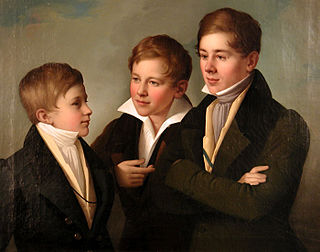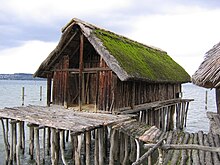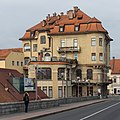
Ljubljana is the capital and largest city of Slovenia, located along a trade route between the northern Adriatic Sea and the Danube region, north of the country's largest marsh, inhabited since prehistoric times. It is the country's cultural, educational, economic, political and administrative center.

Jože Plečnik was a Slovene architect who had a major impact on the modern architecture of Vienna, Prague and of Ljubljana, the capital of Slovenia, most notably by designing the iconic Triple Bridge and the Slovene National and University Library building, as well as the embankments along the Ljubljanica River, the Ljubljana Central Market buildings, the Ljubljana cemetery, parks, plazas etc. His architectural imprint on Ljubljana has been compared to the impact Antoni Gaudí had on Barcelona.

The Triple Bridge comprises three bridges spanning the Ljubljanica River in Ljubljana, the capital of Slovenia. It connects the historical medieval town on the southeastern bank with the central Prešeren Square on the northwestern bank. Dating back to the 13th century, it stands as the oldest bridge in Ljubljana. In the early 1930s, the architect Jože Plečnik redesigned and expanded it. In August 2021, the Triple Bridge was added to the UNESCO World Heritage List as part of Plečnik's enduring legacy.

Prešeren Square is the central square in Ljubljana, the capital of Slovenia. It is part of the old town's pedestrian zone and a major meeting point where festivals, concerts, sports, political events, and protests take place. It was redesigned according to plans by Edvard Ravnikar from a funnel-shaped to a circular form in 1987–88 and renovated in 2007.

Maximilian Fabiani, commonly known as Max Fabiani was an Italian architect, born in the village of Kobdilj near Štanjel on the Karst Plateau, County of Gorizia and Gradisca, in present-day Slovenia. Together with Ciril Metod Koch and Ivan Vancaš, he introduced the Vienna Secession style of architecture in Slovenia.
Vojteh Ravnikar was a Slovenian architect.

Slovene culture is the culture of the Slovenes, a south Slavic ethnic group. It is incredibly diverse for the country's small size, spanning the southern portion of Central Europe, being the melting pot of Slavic, Germanic and Romance cultures while encompassing parts of the Eastern Alps, the Pannonian Basin, the Balkan Peninsula and the Mediterranean.

Ivan Vurnik was a Slovene architect that helped found the Ljubljana School of Architecture. His early style in the 1920s is associated with the search for Slovene "National Style", inspired by Slovene folk art and the Vienna Secession style of architecture. Upon embracing the functionalist approach in the 1930s, Vurnik rivaled the more conservative Plečnik's approach. The Cooperative Business Bank, designed by Vurnik and his wife Helena Kottler Vurnik who designed the decorative facade in the colors of Slovene tricolor, has been called the most beautiful building in Ljubljana. Vurnik has also drawn a number of urban plans, among these the plans for Bled (1930), Kranj (1933–1937), and Ljubljana (1935).

Ljubljana Town Hall is the town hall in Ljubljana, the capital of Slovenia, is the seat of the City Municipality of Ljubljana. It is located at Town Square in the city centre close to Ljubljana Cathedral.

Congress Square is one of the central squares in Ljubljana, the capital of Slovenia. In the late 1930s, the square was renovated by the prominent Slovene architect Jože Plečnik. Since August 2021, it has been inscribed as part of Plečnik's legacy on the UNESCO World Heritage List.

St. Peter's Parish Church is a Roman Catholic church in Ljubljana, the capital of Slovenia. It is one of the oldest churches in Ljubljana and is the seat of Ljubljana–St. Peter parish. It is located in the Center District, at the corner of Trubar Street, Njegoš Street and Zalog Street, near Croatian Square. The University Medical Centre Ljubljana is situated in the immediate vicinity.

The Mladika Complex, the headquarters of the Ministry of Foreign Affairs of the Republic of Slovenia, is a complex of two buildings in the Center District of the capital city of Ljubljana. The first building, at the address 25 Prešeren Street, is L-shaped and stands at the intersection of Prešeren Street and Šubic Street. The other, at the address 11 Šubic Street, stands at the intersection of Šubic Street and Bleiweis Street.

Edvard Ravnikar was a Slovenian architect.

Navje Memorial Park, the redesigned part of the former St. Christopher's Cemetery, is a memorial park in Ljubljana, the capital of Slovenia. It is located in the Bežigrad district, just behind the Ljubljana railway station.

The Cankar Centre or Cankar Hall is the largest Slovenian convention, congress and culture center. The building was designed by the architect Edvard Ravnikar and was built at the southern edge of Republic Square in Ljubljana between 1977 and 1982. Construction was funded entirely by the Socialist Republic of Slovenia.

The National Assembly Building, officially the Assembly of the Republic of Slovenia, also colloquially the Parliament in Ljubljana, the capital of Slovenia, is a modernist palace housing the legislature of Slovenia. Built between 1954 and 1959 upon plans by the architect Vinko Glanz, it is a three-story building with an area of 2,200 m2 (24,000 sq ft). It is located at Republic Square in the center of Ljubljana. Annual visitor numbers are around 13,000.

Ciril Metod Koch was a Slovene architect. Together with Max Fabiani, he introduced the Vienna Secession style in the Slovene Lands.
Savin Sever was a Slovene architect. He was the son of a lawyer from the Littoral temporarily working in Krško, but he grew up in Maribor and Ljubljana.

Art of Slovenia refers to all forms of visual art in or associated with Slovenia, both before and after the country's Independence from Yugoslavia in 1991. Art in Slovenia has been shaped by a number of Slovenian painters, sculptors, architects, photographers, graphics artists, comics, illustration, and conceptual artists. The most prestigious institutions exhibiting works of Slovene visual artists are the National Gallery of Slovenia and the Museum of Modern Art in Ljubljana.












































